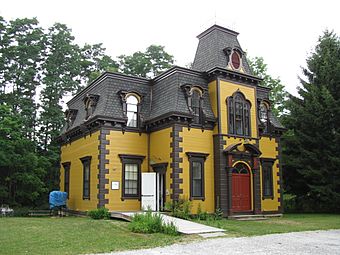Citizens Hall facts for kids
|
Citizens Hall
|
|
|
U.S. Historic district
Contributing property |
|

Citizens Hall
|
|
| Location | 13 Willard Hill Rd., Interlaken, Massachusetts |
|---|---|
| Area | 2 acres (0.81 ha) |
| Built | 1870 |
| Architect | Charles T. Rathbun |
| Architectural style | Second Empire, Italianate |
| Part of | Old Curtisville Historic District (ID76000250) |
| NRHP reference No. | 72000126 |
Quick facts for kids Significant dates |
|
| Added to NRHP | June 19, 1972 |
| Designated CP | October 29, 1976 |
Citizens Hall is a really old and important building. It's located at 13 Willard Hill Road in Interlaken, a small village in Stockbridge, Massachusetts. This building was first built in 1870.
When it was new, Citizens Hall was used as a schoolhouse. It was also a place where people from the community could meet. Today, it's home to the IS183 Art School of the Berkshires. Here, people can learn all sorts of art.
Citizens Hall is a great example of a building built in the Second Empire style. Because it's so special, it was added to the National Register of Historic Places in 1972. This means it's officially recognized as an important historic landmark.
What Does Citizens Hall Look Like?
Citizens Hall is a two-story building made of wood. It has a special type of roof called a mansard roof. This roof has four sides, each with two slopes. The lower slope is steeper than the upper one.
The outside of the building has smooth wooden boards. The corners have special stone-like blocks called quoins. The roof also has pretty wooden decorations called brackets.
The front of the building has a part that sticks out. This part has a three-story tower that sticks out even more. The main door is at the bottom of this tower. The tower also has a mansard-style roof with a cool iron railing on top.
Above the main entrance, there's a big window with three parts. Each part has a rounded top. The windows on the first floor also have decorative frames and sills.
A Look Back at History
Citizens Hall was built in 1870. It was designed by an architect named Charles T. Rathbun from Pittsfield, Massachusetts.
At that time, the village was known as Curtisville. It was a mill village, meaning it had factories that used water power. The hall served as both a school and a community center for the people living there.
In 1991, the building found a new purpose. It became the home of the IS183 Art School of the Berkshires. This school helps people learn and create art in a historic setting.



